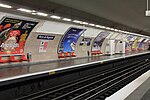Charonne quarter

The Charonne quarter is an area of the 20th arrondissement of Paris named after a former municipality in the area, which was merged into the city of Paris in 1860 by Napoleon III and split between Charonne quarter (south part), the Père-Lachaise quarter and Saint-Fargeau quarter (north part). The historic centre of Charonne is located around the junction of Rue de Bagnolet and Rue Saint-Blaise, in the vicinity of the parish church of Saint-Germain-de-Charonne (which is on the Père-Lachaise quarter). The metro station called Charonne, notable for the demonstration of 8 February 1962, is named after a street in the 11th arrondissement – Rue de Charonne, in the Bastille neighbourhood – and is not actually located in the district of Charonne, which covers the southern half of the 20th arrondissement.
Excerpt from the Wikipedia article Charonne quarter (License: CC BY-SA 3.0, Authors, Images).Charonne quarter
Place Saint-Blaise, Paris 20th Arrondissement (Paris)
Geographical coordinates (GPS) Address Nearby Places Show on map
Geographical coordinates (GPS)
| Latitude | Longitude |
|---|---|
| N 48.860277777778 ° | E 2.4041666666667 ° |
Address
Pharmacie Saint-Blaise
Place Saint-Blaise
75020 Paris, 20th Arrondissement (Paris)
Ile-de-France, France
Open on Google Maps











